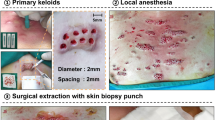Abstract
Introduction
Pyoderma gangrenosum (PG) is a rare autoinflammatory neutrophilic ulcerative skin disease, often developing after a trauma or surgical wounds. In the literature there are several reports of post-surgical PG (PSPG) of the breast. The authors of this article experienced an impressive case of PSPG after an aesthetic breast augmentation mastopexy. PSPG is a rare but severe complication in this elective aesthetic surgical procedure.
Method
A systematic review of the literature was performed, focusing on PSPG after aesthetic breast surgery (augmentation mammoplasty/mastopexy). The online databases Pubmed, Medline, and Cochrane were used and additionally a Google© search was conducted. We compared the data obtained from a systematic literature review to an index case of PSPG after esthetic augmentation mammoplasty.
Results
The literature search identified seven articles describing eight cases of PSPG after aesthetic breast surgery. In four of these cases augmentation mammoplasty had been carried out, in two cases mastopexy and in two cases augmentation mammoplasty and mastopexy (augmentation mastopexy). The patient we treated and describe in this paper underwent an augmentation mastopexy outside our clinic. Eight patients suffered from local disease, at the site of surgical wounds, one patient had disseminated disease. Leukocytosis was present in five cases (out of nine). Eight patients had received corticosteroid treatment, one patient refused such treatment. The duration of corticosteroid treatment was on average for 41 days (range 21–60 days). In all cases, the areola had been spared. Complete healing of PSPG was observed on average after 5 months (range 1.5 months–1 year).
Discussion
PSPG of the breast after aesthetic breast surgery is rare, but every plastic surgeon should consider this possibility, especially if skin disease develops post-surgery, mimicking wound infection that does not respond to broad-spectrum antibiotic treatment.
Conclusion
Although the literature does not recommend this step, implant removal is recommended by the authors because bacterial wound infection normally cannot be ruled out definitely in the early stages of disease. Additional surgical intervention should be limited to the absolute necessary and performed only under adequate systemic immunosuppressive therapy.
Level of Evidence V
This journal requires that authors assign a level of evidence to each article. For a full description of these Evidence-Based Medicine ratings, please refer to the Table of Contents or the online Instructions to Authors www.springer.com/00266.






Similar content being viewed by others
References
Su WPD, Davis MDP, Weening R, Powell FC, Perry HO (2004) Pyoderma gangrenosum; clinicopathologic correlation and diagnostic criteria. Int J Dermatol 43:790–800
Brunsting LA, Goeckerman WH, O’Leary PA (1930) Pyoderma (echthyma) gangrenosum: clinical and experimental observations in five cases occurring in adults. Arch Dermatol Syph. 22:655–680
Goshtasby PH, Chami RG, Michael R (2010) A novel approach to the management of pyoderma gangrenosum complicating reduction mammaplasty. Aesthet Surg J 30:186 e 94
Reddy R, Favreau T, Stokes T, Skopit S (2011) Pyoderma gangrenosum following breast reconstructive surgery: a case report of treatment with immunosuppression and adjunctive xenogeneic matrix scaffolds. J Drugs Dermatol 10(5):545–547
Rietjens M, Cuccia G, Brenelli F, Manconi A, Martella S, De Lorenzi F (2010) A pyoderma gangrenosum following breast reconstruction: a rare cause of skin necrosis. Breast J 16(2):200–202
Caterson SA, Nyame T, Phung T, Lee B, Tobias AM (2010) Pyoderma gangrenosum following bilateral deep inferior epigastric perforator flap breast reconstruction. J Reconstr Microsurg 26(7):475–479
Simon AM, Khuthaila D, Hammond DC, Andres A (2006) Pyoderma gangrenosum following reduction mammaplasty. Can J Plast Surg 14(1):37–40
Sotillo-Gago I, Munoz-Pérez M, Camacho-Martinez F (1999) Pyoderma gangrenosum after augmentation mammaplasty. Acta Derm Venereol 79:486
Poucke SV, Jorens PG, Peeters R, Jacobs W, de Beeck BO, Lambert J, Beaucourt L (2004) Pyoderma gangrenosum: a challenging complication of bilateral mastopexy. Int Wound J 1:207–213
Ouazzani A, Berthe JV, de Fontaine S (2007) Post-surgical pyoderma gangrenosum: a clinical entity. Acta Chir Belg 107(4):424–428
Bonamigo RR, Behar PR, Bellar C, Bonfa R (2008) Pyoderma gangrenosum after silicone prosthesis implant in the breasts and facial plastic surgery. Int J Dermatol 47:289–291
Duval A, Boissel N, Servant JM, Santini C, Petit A, Vignon-Pennamen MD (2011) Pyoderma gangrenosum of the breast: a diagnosis not to be missed. J Plast Reconstr Aesthet Surg 64(1):e17–e20
González de Vicente R, Amorrortu J, Gallo S, Folch J, González Martínez R (2011) Superficial granulomatous pyoderma gangrenosum as a complication in mammoplasty. Cir plást Iberolatinoam 37:51–54
Apalla Z, Lallas A, Karteridou A, Sotiriou E, Papaioannou K, Chaidemenos G (2013) Pyoderma gangrenosum complicating mammoplasty. Int Wound J 10(2):237–238
Powell FC, Collins S (2000) Pyoderma gangrenosum. Clin Dermatol 18:283–293
Acknowledgments
The authors have no financial or personal relationships with other people or organizations that could inappropriately influence this work. No funding was received for this work.
Author information
Authors and Affiliations
Corresponding author
Rights and permissions
About this article
Cite this article
Larcher, L., Schwaiger, K., Eisendle, K. et al. Aesthetic Breast Augmentation Mastopexy Followed by Post-surgical Pyoderma Gangrenosum (PSPG): Clinic, Treatment, and Review of the Literature. Aesth Plast Surg 39, 506–513 (2015). https://doi.org/10.1007/s00266-015-0499-3
Received:
Accepted:
Published:
Issue Date:
DOI: https://doi.org/10.1007/s00266-015-0499-3




